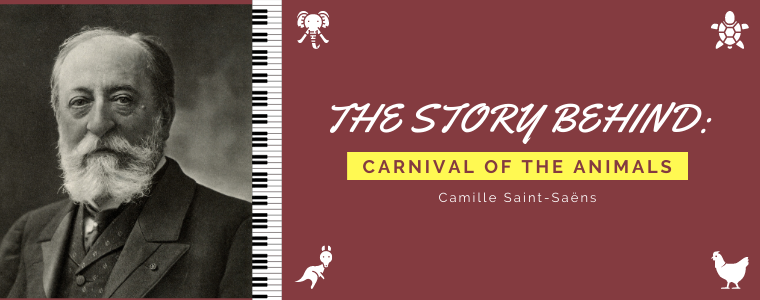The Story Behind: Carnival of the Animals

Composer Camille Saint-Saëns (1835-1921) composed Le Carnaval des Animaux (Carnival of the Animals) in 1886 while taking a vacation in a small, beautiful Austrian village. The whimsical suite features 14 different movements, each one featuring an animal or group of animals.
In the past century and a half, the work has become one of the romantic-era composer’s most famous works, which is ironic because he was a bit embarrassed about it being published at all.
From the Serious Spawns the Whimsical
At the time, Camille Saint-Saëns at the height of his musical and compositional career. By the year 1886, he had garnered widespread public acclaim and was known as a serious and mature composer. Saint-Saëns was already well-admired by the public for previous piano and violin concertos as well as other orchestral pieces. The pianist, organist, and composer had also published and performed several operas by that time. Although his operas didn’t gain much public traction in the moment, they didn’t diminish his reputation either.
By the mid-to-late 1870s, Saint-Saëns enjoyed positive receptions in his honor across the European continent, adding to his reputation as a respected composer with his Danse Macabre in 1874, a superb First Cello Concerto, Op. 33, and a fourth piano concerto in 1875.
The year 1886 was an intense one for Saint-Saëns. He embarked on his Symphony #3 Organ in C minor, Op. 78. A San Francisco Symphony program note describes how immensely challenging the creative process was for him, “On May 18, 1886, Saint-Saëns wrote from London to his publisher, Auguste Durand: ‘We have sight-read the symphony. I was right: it is really terribly challenging.’” The process of composing the symphony was so difficult in fact, that Saint-Saëns took a break in the middle of the work and headed to Austria to rest.
Of course for the true composer “a restorative vacation” rarely means a complete break from music because the entire world is filled with song and inspiration. While he may have put his Third Symphony on hold for a bit, Saint-Saëns’ creative and artistic soul became entranced by the musical interpretation of the animals he had witnessed both in the small Austrian vacation town as well as throughout his world travels. (In addition to being a musical genius, Saint-Saëns was an avid world traveler, archaeologist, and writer.)
Thus, The Carnival of the Animals commenced, but only on paper...
Publication Put on Hold for 34 Years
Carnival of the Animals is typically the first of Saint-Saëns’ compositions a classical music lover ever hears and is considered one of his best works. Thus, it’s hard for contemporary musicians and audiences to believe his reluctance to publish and perform the work. Instead, Saint-Saëns struck a deal that the piece would not be published or performed (with one exception noted below) until after his death, which didn’t occur for another 34 years.
The gorgeous and lyrical orchestral piece is 14 movements long. As mentioned before, each one represents a single or group of animals, often depicted with humor and wit and exceptionally creative use of instrumental voicing. We invite you to listen to the Royal Philharmonic performing the full 14 movements as you read their descriptions.
If you aren’t already familiar with the work in its entirety, we suspect you’ll recognize more than one or two of them:
I. Introduction et marche royale du lion (Introduction and Royal March of the Lion)
II. Poules et coqs (Hens and Roosters)
III. Hémiones - animaux véloces (Wild Asses - quick animals)
IV. Tortues (Tortoises)
V. L'éléphant (The Elephant)
VI. Kangourous (Kangaroos)
VII. Aquarium
VIII. Personnages à longues oreilles (Characters with Long Ears)
IX. Le coucou au fond des bois (The Cuckoo in the Depths of the Woods)
X. Volière (Aviary)
XI. Pianistes (Pianists)
XII. Fossiles (Fossils)
XIII. Le cygne (The Swan)
XIV. Finale
There was one exception to Saint-Saëns’ “no publishing rule,” and that was for Movement 13: Le Cygne (The Swans). Watch the famous movement performed by cellist Yo-Yo Ma and pianist Kathryn Stott below:
Ultimately, the Carnival of the Animals feels like the ultimate expression of Saint-Saëns and his many talents. His virtuoso level of musicianship and composition, combined with his powers of archaeological observation, interests in the natural world, and abilities as a storyteller, yielded one of the most entertaining, moving, and famous classical music pieces ever written.

